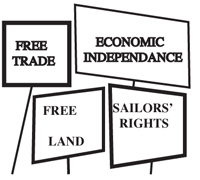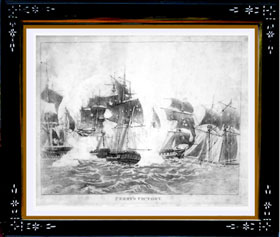Free Trade, Free Land, Sailor's Rights Thirty-four years after the American Revolution, the United States had not yet achieved economic independence. The British Navy routinely blockaded American ports along the Atlantic coast, preventing US merchant ships from importing or exporting goods, and sailors were often kidnapped and forced to serve in the British Navy. In 1810, the twelfth Congressional elections brought “The War Hawks,” a radical coalition of southern Rosenberg further explains, “The pioneer of 1812 was a woodsman. His need of timber was great, for it was essential for building, fencing and fuel. Illinois, Indiana, and the trans-Mississippi regions were regarded as useless, since they were prairie lands. In the period between 1795 and 1809, the Indians parted with approximately forty-eight million acres”… but the War Hawks, who wanted even more free land planned to preemptively invade and conquer Canada. Wood had long been a major trading commodity in the global marketplace. Logging the “pineries” forests of eastern North America had been at issue during the Revolution. “Ships’ masts were one of the New World’s first significant exports, along with cod, potash (derived from charcoal,) and beaver pelts. As early as 1605, samples of white pine from Maine were being sent back to England for testing by the Royal Navy, and by 1691, England’s “Broad Arrow Policy” was in effect. Reflecting the wholesale audacity of the times, this highly unpopular decree stated that any trees twenty-four inches or more in diameter located within three miles of water were automatically the property of the king. Lest there be any confusion about whose woods these were, the royal mark of the “broad arrow” was blazed into the bark. The marked trees were considered so valuable that mast ships – custom built to accommodate long timbers – traveled in convoy with armed escorts” (Vaillant, 54). Invade Canada"There came a halt to the process of taking Indian land when [Indian Chiefs] Tecumseh and the Prophet undertook a reform movement of sweeping scope among the Indians. …Morality, habits, religion did not escape their attention. The result was a powerful Indian confederation. Fearing further growth and power, General Henry Harrison, with the tacit approval of the War Department, forced hostilities upon them. On November 8, 1811, the Indians were defeated at Tippecanoe” (Rosenberg). However, the British continued to control the Great Lakes with six powerful Navy vessels (the US had only one.) A secret plan was put in place to attack the British and Indian Headquarters and a major shipyard at Malden, Canada, northeast of Fort Detroit. The American strategy was to invade Malden by land, capture the British Navy ships while in their homeport, and avoid building our own ships and fighting on water. By the end of May 1812, before war was ever declared, General William Hull had been authorized to start a long march from Dayton, Ohio, past Detroit, with 2000 troops, to invade and capture Malden, Canada. It took Hull and his troops almost a month and a half -- a lot longer than expected -- to march from Dayton to Detroit, arriving July 9th, three weeks after Congress had declared war (Rosenberg, 2ff). Declaration of WarBack in Washington, at the beginning of June 1812, the War Hawks suddenly changed their slogans to “free trade” and “sailors’ rights.”… They demanded that President Madison request that a state of war be declared….The vote was 79 to 49 in the House and 19 to 13 in the Senate. On June 18, 1812, war was declared. …Congress adjourned on July 6, without voting war taxes or providing for an increase of the navy. A short war was expected; a rapid advance would be made into Canada where the inhabitants would welcome the American forces with open arms. The happy face that the War Hawks presented was a win-win-win situation: the U.S. would capture the British Navy, get free Indian land to the west, free Canadian land to the north, and the Canadians would be “liberated” from the British. To avoid opposition, they minimized the real costs of a war in terms of blood and treasure and made economic projections showing that the venture would cost practically nothing. They actively opposed efforts to raise taxes to pay for the invasion, labeling their opponents as wasteful spenders. They argued that once “liberated,” Canadians would be happy to feed and house our troops at no expense to us. The War Hawks opposed efforts to form logistical supply plans or exit strategies, accusing their opponents of wasting officers’ time. Their policies were very much like those of present day neoconservatives. However, something went horribly wrong, and the US commanders neglected to tell General Dearborn that he was to take charge of his forces at Buffalo, march across the Canadian northern shores of Lake Erie and attack Malden from the east. Invasion fails, Detroit and northwestern frontier lost
General William Hull and his 2,000 troops actually did invade Canada on July12, but he wasn’t welcomed and he had no logistical food or supplies. Dearborn and his support troops never showed up, so on August 8, after receiving news that the Indians had captured Fort Mackinac and that British reinforcements were on their way, Hull turned and retreated back to Fort Detroit, suffering heavy troop desertions. This was a boon to the British and Indian forces. They allowed Hull to retreat and then used their Navy to capture everything that moved on Lake Erie. With Detroit’s supply routes cut off, news came that the Indians, after capturing Fort Dearborn in Chicago, had joined British forces and were surrounding Fort Detroit. Fearing a massacre, Hull surrendered without firing a shot. “The last vestige of American authority on the western lakes and the surrounding area was gone. Instead of an early conquest of Upper Canada, our frontier boundaries had been thrown back disastrously to the Wabash and the Maumee. Great doubt was felt whether even that line could be held against the incursions of the British and especially, the Indians"(Rosenberg, 4ff). It is against this backdrop that we understand how difficult a task Perry was given; he wasn’t just fighting the British, he was fighting a breakdown in US military planning and logistical support . Fleet building commencesDaniel Dobbins was an experienced captain of the merchant ship Salina trading in furs and other goods in the Great Lakes region including Lake Huron and points further west. Dobbins was almost captured when Fort Detroit was lost; he survived by hiding neck deep in water under a half sunken gunboat. Under the cover of darkness, he swam to a passing Frenchman in a canoe and eventually, after sailing a boatload of sick and wounded soldiers back to Cleveland, made his way to Washington, DC, where he gave Congress and the Cabinet his eyewitness account of the capture of Detroit and the losses suffered in the Upper Lakes region. “Dobbins was by far the most completely informed person in Washington concerning matters pertaining to Lake Erie. At the conference, plans for a lake force were formulated. Dobbins named Erie as the best and only comparatively safe place for fleet the fleet to be constructed. The Navy Department accepted this advice.”…On the following day, September 16, 1812, Dobbins received an appointment as Sailingmaster in the United States Navy. Thus, the authorization was made for a fleet that was soon to bring world-wide fame to Oliver Hazard Perry and a glorious epic to the history of the United States” (Rosenberg, 9). To find out more about the building of the fleet, select the menu button “The Battle of Lake Erie” then “Building the fleet” on this website. Perry wins Lake Erie and beyond
|
 and western states, to power. Seventy young politicians between the ages of 28 and 39 were elected to the House of Representatives and then appointed to the Speaker of the House and powerful committees including Foreign Relations, Ways and Means, Military Affairs and Naval Affairs. They were a new generation of American politicians who wanted war, but their reasons had nothing to do with free trade or sailor’s rights. Their states didn’t have ships or a coastline or blockaded ports, and they didn’t have sailors – but they wanted free land. What these states had in common were sparse forests, depleted soil and a fear of Indians, who, they imagined, were receiving British logistical support from Canada and French logistical support from Florida. As historian Max Rosenberg explains, “The hunter opened new paths into virgin lands. The pioneer farmer, following closely behind, cleared the free land, quickly exhausted the soil, and moved on. They were followed by the true immigrant settler who bought the land and stayed. Thus by 1812, Tennessee, Kentucky, and much of Ohio and Indiana were permanently settled. The hunter and the pioneer farmer could go no further…”
and western states, to power. Seventy young politicians between the ages of 28 and 39 were elected to the House of Representatives and then appointed to the Speaker of the House and powerful committees including Foreign Relations, Ways and Means, Military Affairs and Naval Affairs. They were a new generation of American politicians who wanted war, but their reasons had nothing to do with free trade or sailor’s rights. Their states didn’t have ships or a coastline or blockaded ports, and they didn’t have sailors – but they wanted free land. What these states had in common were sparse forests, depleted soil and a fear of Indians, who, they imagined, were receiving British logistical support from Canada and French logistical support from Florida. As historian Max Rosenberg explains, “The hunter opened new paths into virgin lands. The pioneer farmer, following closely behind, cleared the free land, quickly exhausted the soil, and moved on. They were followed by the true immigrant settler who bought the land and stayed. Thus by 1812, Tennessee, Kentucky, and much of Ohio and Indiana were permanently settled. The hunter and the pioneer farmer could go no further…”
 centerpiece in securing our Canadian border, protecting westward expansion, and snatching naval ascendance from the British navy. To find details about Perry’s contribution to this nine-phase campaign, select
< Battle of Lake Erie- Building Alliances> from the menu bar. Land and sea battles continued to be fought along the Atlantic coast, Plattsburgh inland waterways, and elsewhere including the capture and burning of the White House, Capitol building in Washington, D.C.
centerpiece in securing our Canadian border, protecting westward expansion, and snatching naval ascendance from the British navy. To find details about Perry’s contribution to this nine-phase campaign, select
< Battle of Lake Erie- Building Alliances> from the menu bar. Land and sea battles continued to be fought along the Atlantic coast, Plattsburgh inland waterways, and elsewhere including the capture and burning of the White House, Capitol building in Washington, D.C.


